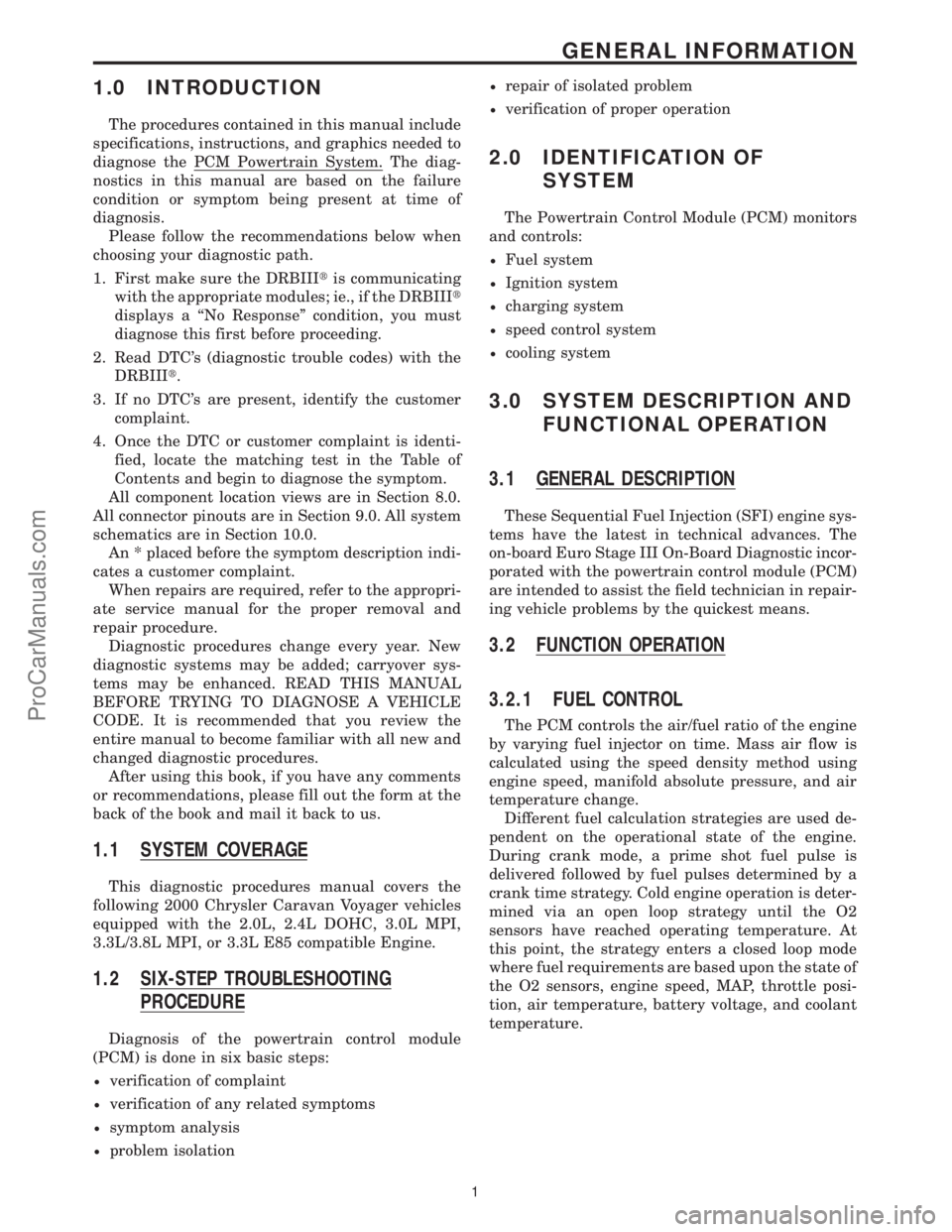cooling CHRYSLER VOYAGER 2000 Diagnostic Manual
[x] Cancel search | Manufacturer: CHRYSLER, Model Year: 2000, Model line: VOYAGER, Model: CHRYSLER VOYAGER 2000Pages: 364, PDF Size: 2.17 MB
Page 7 of 364

1.0 INTRODUCTION
The procedures contained in this manual include
specifications, instructions, and graphics needed to
diagnose the PCM Powertrain System. The diag-
nostics in this manual are based on the failure
condition or symptom being present at time of
diagnosis.
Please follow the recommendations below when
choosing your diagnostic path.
1. First make sure the DRBIIItis communicating
with the appropriate modules; ie., if the DRBIIIt
displays a ``No Response'' condition, you must
diagnose this first before proceeding.
2. Read DTC's (diagnostic trouble codes) with the
DRBIIIt.
3. If no DTC's are present, identify the customer
complaint.
4. Once the DTC or customer complaint is identi-
fied, locate the matching test in the Table of
Contents and begin to diagnose the symptom.
All component location views are in Section 8.0.
All connector pinouts are in Section 9.0. All system
schematics are in Section 10.0.
An * placed before the symptom description indi-
cates a customer complaint.
When repairs are required, refer to the appropri-
ate service manual for the proper removal and
repair procedure.
Diagnostic procedures change every year. New
diagnostic systems may be added; carryover sys-
tems may be enhanced. READ THIS MANUAL
BEFORE TRYING TO DIAGNOSE A VEHICLE
CODE. It is recommended that you review the
entire manual to become familiar with all new and
changed diagnostic procedures.
After using this book, if you have any comments
or recommendations, please fill out the form at the
back of the book and mail it back to us.
1.1 SYSTEM COVERAGE
This diagnostic procedures manual covers the
following 2000 Chrysler Caravan Voyager vehicles
equipped with the 2.0L, 2.4L DOHC, 3.0L MPI,
3.3L/3.8L MPI, or 3.3L E85 compatible Engine.
1.2 SIX-STEP TROUBLESHOOTING
PROCEDURE
Diagnosis of the powertrain control module
(PCM) is done in six basic steps:
²verification of complaint
²verification of any related symptoms
²symptom analysis
²problem isolation
²repair of isolated problem
²verification of proper operation
2.0 IDENTIFICATION OF
SYSTEM
The Powertrain Control Module (PCM) monitors
and controls:
²Fuel system
²Ignition system
²charging system
²speed control system
²cooling system
3.0 SYSTEM DESCRIPTION AND
FUNCTIONAL OPERATION
3.1 GENERAL DESCRIPTION
These Sequential Fuel Injection (SFI) engine sys-
tems have the latest in technical advances. The
on-board Euro Stage III On-Board Diagnostic incor-
porated with the powertrain control module (PCM)
are intended to assist the field technician in repair-
ing vehicle problems by the quickest means.
3.2 FUNCTION OPERATION
3.2.1 FUEL CONTROL
The PCM controls the air/fuel ratio of the engine
by varying fuel injector on time. Mass air flow is
calculated using the speed density method using
engine speed, manifold absolute pressure, and air
temperature change.
Different fuel calculation strategies are used de-
pendent on the operational state of the engine.
During crank mode, a prime shot fuel pulse is
delivered followed by fuel pulses determined by a
crank time strategy. Cold engine operation is deter-
mined via an open loop strategy until the O2
sensors have reached operating temperature. At
this point, the strategy enters a closed loop mode
where fuel requirements are based upon the state of
the O2 sensors, engine speed, MAP, throttle posi-
tion, air temperature, battery voltage, and coolant
temperature.
1
GENERAL INFORMATION
ProCarManuals.com
Page 57 of 364

Symptom:
P-0125 CLOSED LOOP TEMP NOT REACHED
When Monitored and Set Condition:
P-0125 CLOSED LOOP TEMP NOT REACHED
When Monitored: After engine is started, for ten minutes.
Set Condition: The engine temperature does not go above 10 degrees C (50 degrees F) by
13 minutes after the engine is started for 2 consecutive trips.
POSSIBLE CAUSES
PCM CONNECTOR AND TERM DAM, PSHD OUT, OR MISWIRED
ECT SENSOR CONN AND TERM DAM, PSHD OUT, MISWIRED
ECT SENSOR RESISTANCE >=11.00 K OHMS
PCM DEFECTIVE
THERMOSTAT DEFECTIVE
TEST ACTION APPLICABILITY
1 Turn the ignition on.
With the DRB, read the FREEZE FRAME DATA.
Using the FREEZE FRAME DATA, attempt to duplicate the condition that has set
this fault.
Note that the DTC is a 2 trip failure.
Does P0121 reset?All
Ye s®Go To 3
No®Go To 2
2 The conditions required to set the DTC are no longer present.
Ensure the engine cooling system is operating properly, coolant level is at specifica-
tion, and no external or internal coolant leaks. Refer to the appropriate service
category for cooling system information.
Is the Cooling System operating correctly?All
Ye s®Test complete
No®Repair as necessary.
Perform Powertrain verification Test VER-5A
3 Ignition off.
Disconnect the ECT Sensor Connector.
Note: Check Connectors - clean/repair as necessary.
Is any Terminal damaged, pushed out, or miswired?All
Ye s®Clean or repair connector as necessary.
Perform Powertrain Verification Test VER-5A.
No®Go To 4
51
DRIVEABILITY
ProCarManuals.com
Page 183 of 364

Symptom:
P-1281 ENGINE IS COLD TOO LONG
When Monitored and Set Condition:
P-1281 ENGINE IS COLD TOO LONG
When Monitored: Ignition key on, engine not running. Ambient temperature greater
than þ11ÉC (-11ÉF) and coolant temperature greater than þ7ÉC (19ÉF)
Set Condition: The engine does not warm to 79 degrees C (176 degrees F) while driving
for 20 minutes after start.
POSSIBLE CAUSES
ENGINE COLD TOO LONG
TEST ACTION APPLICABILITY
1 Start Engine
Drive vehicle under normal driving conditions for 20 minutes.
With the DRB, read Engine Coolant Temperature.
Did the engine warm to 79 degrees C (176 degrees F)?All
Ye s®Test Complete.
No®See pertinent service manual information for cooling system
diagnostics.
177
DRIVEABILITY
ProCarManuals.com